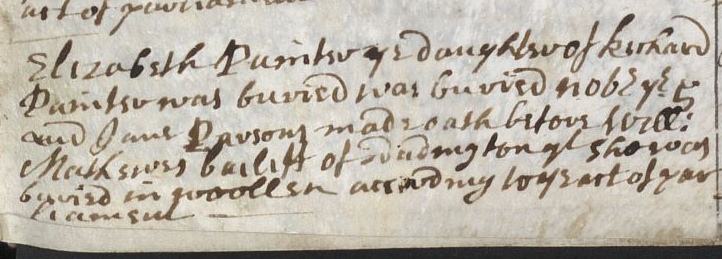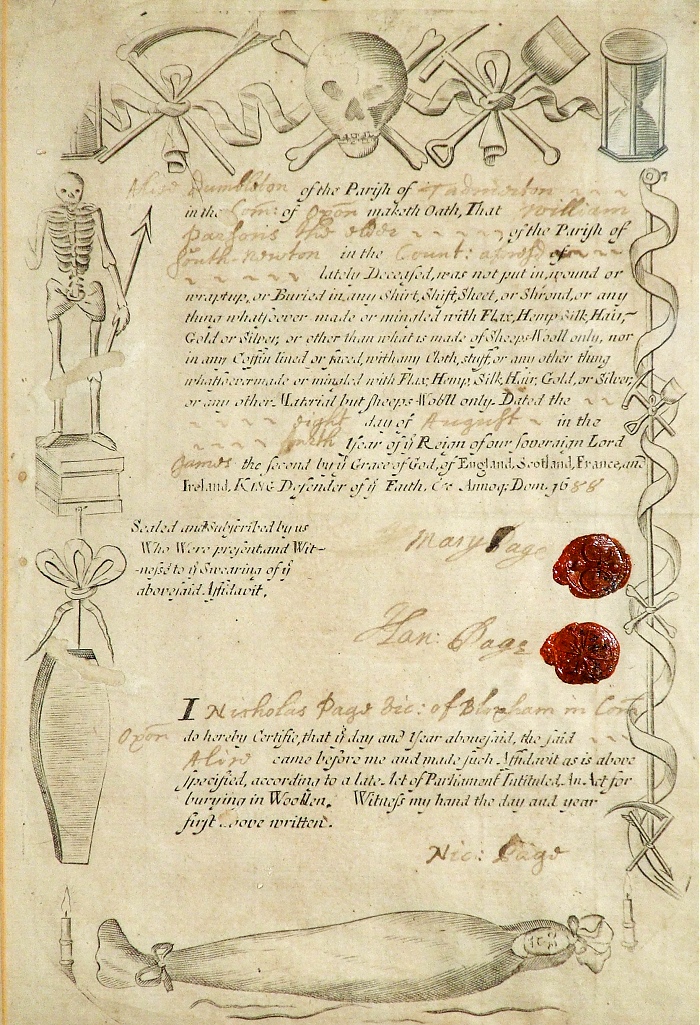![Link to OFHS front page [logo]](logo100.gif)
![Link to OFHS site map [logo]](logo100.gif)
| SEARCH SERVICE INDEXES |
|---|
|
What is the Search Service for?
How do I start?
What date range do the parish indexes cover?
Are the indexes complete?
How do I tell which parishes are included?
Where do I go from here? |
| SOME GENERAL POINTS |
|---|
|
That's not my ancestor. He spelt his name differently!
That's not my ancestor. His name is in Latin!
That's not my ancestor. His age is wrong!
What are Bishop's Transcripts and how do they differ from Parish Registers? The principle snag with BTs is that for each parish the BT for a single year was on a small slip of paper. This is the form in which they have been kept. So the BTs for a parish consist of lots of slips of paper bundled together. With this sort of arrangement it is all too easy for individual slips, or indeed a whole bundle, to have got lost over the years. So BTs tend to be a resource with rather frequent gaps. However if the original registers have been lost they are certainly better than nothing! For Oxfordshire Parishes, the OFHS book "Oxfordshire Parish Registers and Bishop's Transcripts" by Colin Harris is the definitive description of what PRs and BTs have survivied and where they are now to be found.
But my ancestors are in IGI (on FamilySearch). Why can't you find them? It is important to remember that IGI was created for the purposes of the LDS religion. Mormons believe that dead ancestors should be offered the opportunity of being baptised into the LDS Church. (See http://mormon.org/faq/#Baptism for more details.) For this to take place, it is necessary to know when and where the person was born. If no original record can be found, a "best guess" will be made based on such data as is available. So if a person married and died in a particular parish, it will be assumed that they were born there and an estimate of their birth date will be made from their age at death, if this was recorded, or an assumption that they were aged around 21 when they married and started to raise children, if no better basis can be found. As Family Historians it is important not to regard such records as anything more than guesses. They are no more or less likely to be correct than our own guesses and certainly should not be regarded as corroborative evidence. Such records can often by spotted by the date being quoted as "About" or as just a year, with no actual date, but you should also get into the habit of viewing the items under the "Messages:" or "Source Information:" headings at the foot of the record. These will always tell you the origin of the record and you can then make your own assessment of its reliability.
How do I find the source of data on the new FamilySearch web site? The default situation when searching for records, now starts by listing transcribed material, under the heading "Search Results for Historical Records". Submitted material is only displayed at the foot of the page under the heading "Search Results from User Submitted Trees". Unfortunately it has now become far less intuitive to find out details of the actual source used. On the old site when viewing an individual record the "Source Information" at the foot of the page included clickable links to a "Batch No.", and a "Source Call No.". The "Batch No." when clicked allowed you to redefine a search within just that batch number. (This gives a great way of locating siblings for example and this still works on the new site.) The "Source Call No." when clicked took you straight to a page specifying the source record used. This facility has unfortunately been lost on the new site. On the new site, the "Batch No." is now called "indexing project (batch) number:" and is still a clickable link that works as on the old site. Below that you may find entries for a "system origin", a "source film number" and a reference number", but as of December 2012, none of these are clickable links. To discover the source, you must first make a note of the "source film number" Now go back to the opening page of the FamilySearch web site. Immediately below the title for "Discover Your Family History" click the entry for "Catalog". On the screen that appears, select "Film Numbers" from the left hand "Search" drop-down box. and in the right hand "For" box enter the film number you noted down above. Now when you click on "Search" it will reveal the actual source material used. It is rather more tortuous than on the old version of the site but you get there in the end!.
The Calendar: What convention do you use?
In transcripts it is normally easy to tell what convention a particular register is using from the context. In our search indexes that context is lost. Moreover it is not easy to display a dual year within the results. The year field is expected to contain exactly four digits. Moreover attempts to select and sort by date do not understand dual years and are apt to treat 1749/50 as a division sum and show the result as 34.98 which is not at all what was intended! In preparing the indexes we generally use the first four digits of the date as written in the original register. So if the parish is working on Julian dates, it will be the Julian year that appears in the index. If the parish has already adopted Gregorian dates before 1752, the index will show the Gregorian date. If the parish is using dual dates, just the first four digits will appear in the index, which is effectively the Julian date. This is what you will see in an index listing. So there will occasionaly be scope for a one year error, in cases where a parish has adopted the Gregorian calendar in advance of the official start date. The important thing to remember is the point made in the very first paragraph of these "Hints & Tips", that the Search Service is intended as a finding aid, not a complete source of all data. Of course, if you have requested a specific search for a single person, the problem does not arise, since we then supply the full details from the transcript, including dual year dates where appropriate.
The Effects of the Stamp Duty Act of 1783 There was little people could do about burial entries. The dead had still to be buried. It is possible that the act led to an increased number of so-called "common law marriages" (see below). However it is in baptisms that the consequences of the act are most visible to the family historian. Some couples simply did not bother to baptise their children, so you are more likely to encounter "missing baptisms" whilst the act was in force. Some of these children may be found being baptised "in a batch" after 1794 but in other cases baptisms are never recorded for them. (My personal suspicion is that religious beliefs were satisfied by a surreptitious splash of Holy water, but no register entry was ever made. Another effect, seen in some parishes where the incumbent was clearly on the side of his parishioners rather than the government at Westminster, is that whilst the act was in force, a large number of entries in the burial register may be recorded as being "paupers", whilst entries in the baptism register are recorded as being the children of "paupers". (At Leafield for example between April 1787 and November 1790, of 59 baptisms, all but 8 were for "paupers". The practice stops suddenly at this point. Presumably the government noticed!) So if you find your ancestor baptised or buried as a pauper during this period, do not shed too many tears for the family's plight. They were probably not in penury, they just had an obliging vicar! |
| BAPTISMS |
|---|
|
Why were infants baptised?
Why are some baptisms recorded as "privately"?
Was everyone baptised as a baby?
Why was first child baptised away from home?
Why is only the father's name given?
Why is only the mother's name given?
The mothers name is "wrong". |
| MARRIAGES |
|---|
|
Where did a marriage take place?
Does "of the parish of ..." tell you where they were born?
Why can't I find their marriage?
Surely everyone married in church after Lord Hardwicke's marriage act of 1753?
Why did they marry in the City of Oxford when they lived in the country?
What is marriage by banns?
How long were banns valid?
What is marriage by licence?
What is marriage by registrar's certificate?
Who are the witnesses?
Why do some names have an "x" beside them?
They left it a bit late didn't they?
At what age was it legal to marry? It is commonly believed that following Harwicke's marriage act of 1753, a minor (a person under the age of 21) could not legally marry, without the active consent of their parents. This is not strictly true in the case of marriage by banns. When the banns were read (as described above), a parent of a minor could object and so prevent the marriage taking place. However if the banns were read without any parental objection, the subsequent marriage was legally binding. Only in the case of a marriage by licence was the formal active consent of a parent or guardian of a minor required.
Do marriage records include details of occupation and parents?
Marriage to the sibling of a deceased spouse Before these dates you may find such couples living together as man and wife, without a marriage ever having taken place. Alternatively couples might marry somewhere remote from home claiming to be previously unmarried. Depending on the level of local knowledge, and/or the sympathies of the local vicar, children of such couples might be baptised normally with both parents named, or might be baptised as illegitimate, with just the mother named. |
| BURIALS |
|---|
|
Where were they buried?
Can I trust the age in a burial register?
I can't find a burial. What are the alternatives?
Why were they "Buried in Woollen"? 
If you are very lucky you may find an original signed affidavit, such as the one shown here, which is on display in South Newington Church and is included in more detail on OFHS Monumental Inscriptions CD OXF-MI-SNT. 
|
| CIVIL REGISTRATION AND CERTIFICATES |
|---|
|
Where can I get a certificate for a pre-1837 birth / marriage / death?
Can you send me a birth / marriage / death certificate?
His death was registered in 1867 at Chipping Norton (for example), can you look up the burial? The GENUKI web site includes a list of all the Oxfordshire registration districts, together with lists of places covered by each district. You can find it at: www.ukbmd.org.uk/reg/oxf.html |
| CENSUSES |
|---|
|
Can I determine my ancestor's year of birth from their age in a census?
All of the above assumes that your ancestor has correctly told the enumerator their age but this is not necessarily the case. Ages can be recorded wrongly for the reasons discussed near the top of this page. Finally ages in the 1841 census can cause further confusion for the reasons described in the following section.
My ancestor's age in 1841 seems wrong?
My ancestor's birthplace in 1841 seems wrong?
My ancestor seems to be missing in 1841?
My ancestor seems to be missing in 1861? |
Registered Charity Number 275891
© 2009-2021 Oxfordshire Family History Society